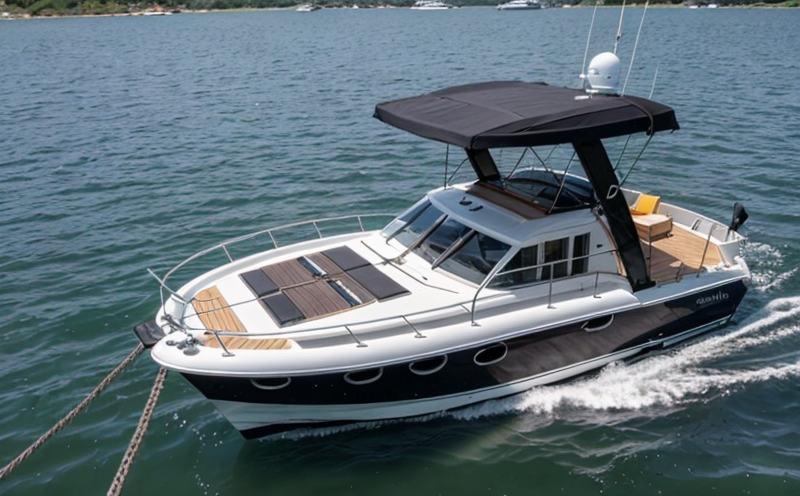ISO 1982 Anchor Bending Resistance Testing
The ISO 1982 standard specifies a method for determining the bending resistance of anchors used in marine and ship equipment testing. This test is crucial for ensuring that anchors are capable of withstanding the forces they will encounter during deployment, particularly those associated with ship maneuvering or mooring operations.
The anchor's ability to resist bending under stress is essential as it directly impacts its durability and reliability in real-world conditions. The test involves subjecting an anchor to a specified load that simulates the bending moment experienced during use. This bending resistance testing ensures compliance with international standards, thereby guaranteeing safety and performance of marine equipment.
The procedure typically includes the following steps: selecting appropriate specimens from production batches, preparing them according to standard procedures, applying loads in a controlled environment, monitoring the deformation until failure occurs or specified limits are reached, recording data accurately, and reporting results comprehensively. Compliance with this test helps manufacturers meet regulatory requirements set forth by various maritime bodies worldwide.
For instance, during testing, an anchor might be subjected to a load that replicates 10% of its ultimate breaking strength as defined in the standard. This value is carefully chosen to reflect realistic operational conditions without causing excessive damage or failure. After applying this load and observing the specimen's behavior under stress, engineers can assess the anchor's performance against established criteria.
The results from these tests play a vital role in product development cycles by providing valuable insights into material properties, design improvements, process optimization, and quality control measures. By adhering to ISO 1982 guidelines, manufacturers ensure their products meet stringent safety standards while also enhancing overall performance characteristics such as strength, flexibility, resistance against corrosion, and fatigue life.
Additionally, conducting regular bending resistance tests allows companies to identify potential issues early on in the production process, preventing costly defects later down the line. This proactive approach not only improves product quality but also fosters trust among customers who rely heavily upon reliable marine equipment for critical operations.
In summary, ISO 1982 anchor bending resistance testing serves as an essential tool for ensuring the integrity and reliability of anchors used in various applications within the maritime industry. By following this internationally recognized standard, manufacturers can produce safe, efficient, and long-lasting products that meet both current regulations and future demands.
Why It Matters
The importance of ISO 1982 anchor bending resistance testing cannot be overstated when considering the safety and longevity of marine equipment. Properly conducted tests ensure anchors can withstand the physical stresses imposed by their intended uses, reducing risks associated with premature failure or excessive wear.
- Enhanced Safety: Ensuring that an anchor meets specified bending resistance requirements significantly reduces the likelihood of accidents caused by weakened hardware failing during critical operations like mooring.
- Durability: Reliable anchors last longer, which is particularly important for vessels operating in harsh environments where constant exposure to saltwater and varying weather conditions can degrade materials over time.
- Fuel Efficiency: Stronger anchors contribute to better vessel stability during maneuvers, potentially leading to improved fuel efficiency by minimizing unnecessary energy expenditure on maintaining control.
- Environmental Impact Reduction: Longer-lasting equipment means less frequent replacements, reducing the amount of waste generated and minimizing disruptions to daily operations.
Incorporating ISO 1982 into your quality management system demonstrates a commitment to excellence within the maritime sector. It positions you as an industry leader who prioritizes both operational efficiency and environmental responsibility.
Quality and Reliability Assurance
- Data Accuracy: Rigorous adherence to ISO 1982 ensures precise measurement of bending resistance, enabling accurate assessment of anchor performance.
- Consistency: Standardized procedures guarantee consistent results across different batches or iterations of the same product line.
- Compliance Verification: Meeting these standards confirms that your products comply with international maritime regulations, opening doors to broader market access and enhancing customer confidence.
- Continuous Improvement: Regular testing provides valuable feedback for refining designs and processes continuously, driving innovation within the company.
The use of ISO 1982 in quality assurance initiatives fosters a culture of excellence among teams involved in manufacturing and testing activities. By integrating these practices into daily operations, organizations can maintain high standards throughout their supply chains while meeting global expectations for safety and sustainability.
Environmental and Sustainability Contributions
The implementation of ISO 1982 anchor bending resistance testing contributes positively to environmental stewardship by promoting the use of durable materials that last longer, thereby reducing waste generation. Longer-lasting anchors mean fewer replacements needed over time, which ultimately leads to lower resource consumption.
Moreover, reliable equipment enhances fuel efficiency for vessels equipped with robust mooring systems, contributing to reduced carbon footprints and operational costs associated with maintaining optimal performance levels. By investing in sustainable practices like ISO 1982 testing, companies demonstrate their dedication to protecting the environment while delivering high-quality products.
The benefits extend beyond individual organizations; they influence broader industry standards by setting benchmarks for what constitutes acceptable quality across various segments of the maritime sector. As more stakeholders adopt similar approaches, collective efforts towards sustainability grow stronger and more effective.





